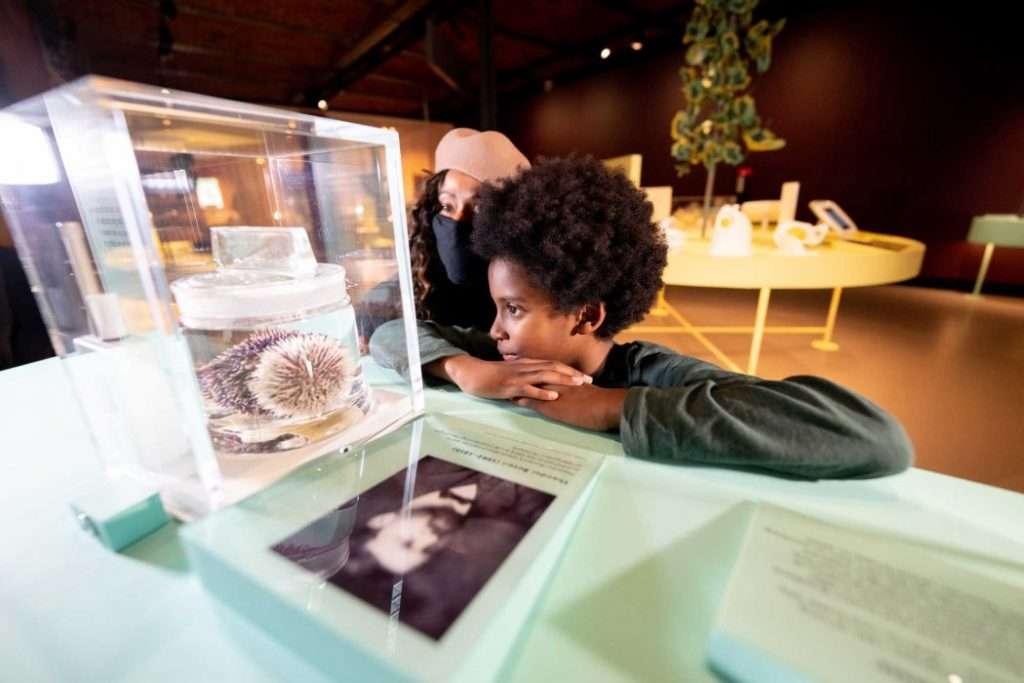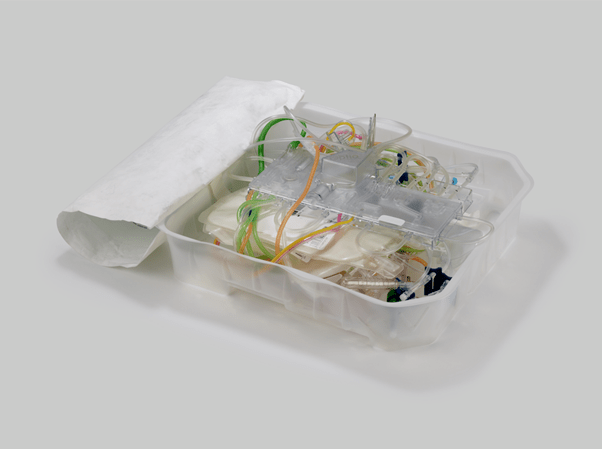One in two of us will be diagnosed with cancer in our lifetime, yet more of us than ever before are living longer and more comfortably with the disease, and beyond. The treatment of cancer has progressed in leaps and bounds, thanks to advances in scientific understanding.
Our exhibition, Cancer Revolution: Science, Innovation and Hope, was created with support from expert partner Cancer Research UK, which celebrates its 20th birthday today, and has been developed with an advisory board of patients, doctors and scientists who provided insights and expert guidance on the powerful stories featured throughout.
To get an overview of the past, present and future of how we live with and treat cancer, visitors can see 125 objects, from a dinosaur tumour to a 30s vintage radium radiotherapy machine, to the latest cancer research treatments and technologies, including the ‘cytosponge’ used for diagnosis, along with over 30 moving personal accounts. There are works of art too.
Katie Dabin, Lead Curator, remarked: “While we can’t cancer-proof our lives, more people than ever before can be treated or live with the disease for a long time and we can take agency in the face of it—from speaking more openly about it, being aware of its causes and symptoms, dispelling misconceptions and stigma, and being open to finding out more about it.”

The exhibition has fast become a must-visit experience at the Science and Industry Museum in Manchester, as Director, Sally MacDonald, says: ‘we have been moved, humbled and blown-away by the incredible feedback visitors are sharing with us. This is a very special exhibition experience on a subject which is resonating strongly”.
Tens of thousands of visitors have seen Cancer Revolution at the Science and Industry Museum, where it runs until March, and tens of thousands more are expected to visit when it opens at the Science Museum from May.
We asked our exhibition advisors the following questions: what is the cancer advance that has meant the most to you and why? And, given the amazing advances in the past 20 years, what do you hope or expect in the next 20?
Here are their replies:
Professor Dan Davis, author, Visiting Professor at Imperial College London, and Director of Research in the Manchester Collaborative Centre for Inflammation Research:
Multiple myeloma is a cancer which cannot be cured. But that’s not to say there hasn’t been progress. My grandmother died in 2000, having had myeloma for four and a half years. At the time, the number of treatments for myeloma was limited and she was only expected to live for up to three years after being diagnosed. Some years later, in 2008, my father was diagnosed with the same condition and was told he could expect to live about four years. But new treatments for myeloma – and some luck, I guess – has meant that he has so far survived for nearly 14 years.
Our ability to harness the power of our immune system to fight cancer has only just begun. There are countless new ideas along these lines being tested now, for example, developing new kinds of CAR T cell or antibody-based medicines. It’s hard to say exactly how this will pan out but surely, in 20 years a lot of new immunotherapies will be available that work better and with less risk of side-effects. I also think that as we develop new immune therapies for cancer, there will be spin-offs to help tackle other types of illness, such as auto-immune disease.

Deborah James, Sun columnist, blogger as ‘Bowelbabe’ campaigner, fundraiser for a range of cancer charities and newly appointed Science Museum Group Fellow:
As a patient advocate, for me it’s the idea that my cancer is as unique as I am, that we can see personalisation of treatment coming through that has more of a chance of working specifically for ME and MY tumours, rather than banding all “bowel cancer” as the same. I’ve been given five extra years since being diagnosed because of this approach – 20 years ago I wouldn’t have had the same lifeline.
I hope for my children that should they ever be in my situation, science will give them 30 years more at least. Patients need hope and personalised options. We need to know we aren’t a generalised statistic. Science and research provides the hope that we just might see a future we never thought possible. That hope allows us to walk forward, even in our darkest times.

Image credit: Deborah James
Professor Charles Swanton, CRUK’s chief clinician, Fellow and Group Leader of the Translational Cancer Therapeutics laboratory at the Francis Crick Institute, London:
For me it is the power of the immune system to target evolving cancers that has been the greatest advance with the introduction of checkpoint inhibitor therapies, CART-T therapies and cellular therapies.
What we have learned over the last 20 years is science turns the impossible into the possible, with breakthroughs in so many areas including targeting the untargetable cancer genes- such as KRAS, present in approximately 25% of tumours.
Over the next 20 years we can anticipate breakthroughs in many more areas including in early diagnosis through detection of early cancer signals in blood, stool and urine, and targeting many more cancer genes that were previously considered un-targetable.
And last but not least we will learn to make the immune system young again, with genetic engineering resulting in diverse and possibly infinite potential to target evolving cancers. So yes- I am very excited!

Terry Kavanagh, a long-term lung cancer survivor who was diagnosed over 31 years ago:
The major advance for me in the last twenty years is seeing the openness and acceptability by the public in facing cancer. People now accept the challenge! Cancer research has advanced so much in that time that for newly diagnosed patients the hope of a cure is now a reality.
In the next twenty years I see cancer treatment advancing from a potential terminal disease to a chronic manageable illness. What was once seen as the impossible will become the possible. Perhaps advances in cancer research will see the disease cured by an injection.
Professor Paul Workman, former Chief Executive and President of The Institute of Cancer Research
The advance that means the most to me is the discovery of drugs that really are personalized medicines that are given to patients to exploit a particular abnormality in the genome sequence of their cancer cells. So rather than traditional one-size-fits-all treatment – where all patients with a certain overall type of cancer are given the same drug and it’s not known who will respond – with personalized medicines the appropriate drug is given to individual patients with a high likelihood of success based on the genome sequence. I’m pleased to have contributed to this.
We need to expand the availability of personalized medicines. Currently only around 5% of cancer genome abnormalities have a corresponding personalized medicine to suit. I expect to see an increasing number of cancer targets to change from being classified as ‘undruggable’ to become ‘successfully drugged’. This will help us increase long term survival and cures across all cancers, even those that currently have the worst outcomes. It will also allow us to build a greater variety of combination drug cocktails that will overcome the propensity of cancers to adapt, evolve and become resistant. And as we discover and develop these better treatments, we need to make sure that patients can actually access and benefit from them.



The exhibition, shows that cancer care is not just about drugs, however. Over the past century, treatment has been revolutionised in many different ways, from surgery and radiotherapy, the development of kinder therapies to earlier diagnosis, understanding of the links with lifestyle – from smoking and diet to sunbathing – and the explosion of insights into the genetics of the disease.
One milestone for UK research came in July 1902, when the Cancer Research Fund was set up by Mr. Henry Morris, a member of the Council of the Royal College of Surgeons, with the help of an “anonymous gentleman ” who anticipated that – through his City connections – he would be able to raise at least £100,000 for research on the prevailing theory that cancer was caused by microbes.
With the consent of King Edward VII the Cancer Research Fund quickly evolved into the Imperial Cancer Research Fund and, after decades of mergers – notably with the Cancer Research Campaign that began as the British Empire Cancer Campaign in 1923 – two decades ago became Cancer Research UK, the world’s largest independent cancer research charity.
However, the fate of the prevailing theory at the dawn of Cancer Research UK is in itself a reminder that the trajectory of science is non-linear and unpredictable. The microbe theory of cancer ran into trouble in the early 20th century when it proved difficult to isolate a “cancer germ” analogous to the kind known to cause diseases such as TB.
Today, however, we know that certain viruses do cause cancers, notably cervical cancer, and the bacterium Helicobacter pylori is a major cause of gastric cancer. Those insights have paved the way for an effective vaccine against cervical cancer, while testing and treatment for H. pylori infection can reduce or prevent gastric cancer.
The quest to understand how other viruses cause cancer also led to the identification of critical human oncogenes, which are linked with cancer. This, in turn, has led to treatments. As one example, by targeting genes such as EGFR with drugs, the deaths caused by hard-to-treat lung cancer have dropped.
Michelle Mitchell, Cancer Research UK’s Chief Executive said: ” So much progress has been made in the global fight against the disease, and this inspirational exhibition reflects our optimism for the future; a feeling which we hope visitors will take away with them.”
For more information about the Cancer Revolution: Science, innovation and hope exhibition and to book free tickets to see it at the Science Museum from May, visit https://www.sciencemuseum.org.uk/see-and-do/cancer-revolution-science-innovation-and-hope
At the Science Museum, the exhibition is funded by principal sponsor Pfizer, with support from Julian Howard.
Other members of our exhibition advisory board include: Prof Karen Vousden, Cancer Research UK’s Chief Scientist and Group Leader at the Francis Crick Institute; Prof Daniel Hochhauser, a consultant medical oncologist at UCL; Natasha Lomax, who was diagnosed with Hodgkin’s Lymphoma (a type of blood cancer) in 2016 and a member of two panels at CRUK and one with UCLH; and Freya Parry, Head of Research Information, Communication and Engagement at Cancer Research UK.
For more information on 20 years of Cancer Research UK visit https://news.cancerresearchuk.org/topic/20th-anniversary/